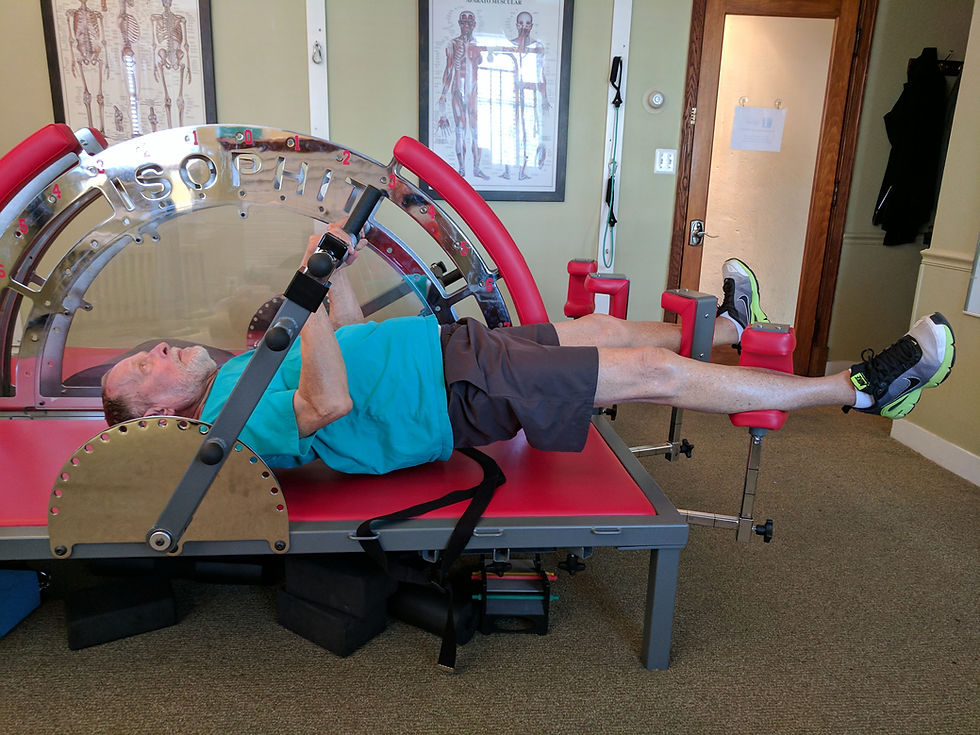What Are Myokines – And Why You Need More of Them
- Ryan Fritz
- Aug 1
- 4 min read

You most likely know that muscles are good for more than just looking strong or
performing better at the gym. But here's something you might not know: when you exercise, specifically resistance training, your muscles actually behave like an endocrine organ. That means they release chemical messengers that travel
throughout the body and affect everything from inflammation to brain function.
These messengers are called myokines.
This topic is getting a lot of recognition lately, and for a good reason.
Understanding myokines opens up a whole new world of appreciation for exercise, especially isometric training. Just keep reading and you'll find out everything!
What Exactly are Myokines?
Myokines are small proteins released by our skeletal muscles during muscle
contractions. Once released into the bloodstream, they act like signaling molecules, communicating with different organs and systems in our body— including brain, liver, bones, fat tissue, and even immune system.
Scientists have discovered hundreds of myokines, but we’re still in the early stages of understanding what many of them do. What we do know is that some of them
have powerful anti-inflammatory, metabolic, and neuroprotective effects.
In simple terms: when your muscles contract, they don’t just get stronger—they also
help your entire body function better.
Why are Myokines Important?
Let's take a look at the benefits which myokines offer:
1. Less Inflammation
One of the best recognized roles of myokines is in controlling chronic inflammation, which is at the root of many diseases—heart disease, type 2 diabetes, Alzheimer’s, and more. For example, IL-6, one of the most studied myokines, has a complex role.
When it comes from fat cells (as in obesity), it promotes inflammation. But when it comes from muscle during exercise, it does the opposite—it helps reduce
inflammation and improves insulin sensitivity.
2. Fat Metabolism
Some myokines can help regulate fat metabolism, encouraging the body to break down fat for energy. This makes resistance training and muscle-building even more vital for weight management.
For example, irisin is a myokine linked with converting white fat into
"usable fat" that is more metabolically active and ready to be burned.
3. Cognitive Boost
Certain myokines can also cross the blood-brain barrier, meaning they directly affect your brain. Research suggests that myokines like BDNF promote neurogenesis (the growth of new brain cells) and may help protect against depression and cognitive
decline.
4. Better Immune Function
Regular muscle contractions help balance the immune system. Rather than
overstimulating it (which can lead to chronic inflammation), myokines help regulate
how your body responds to stress, injury, and infection.
How to Get More Myokines = Isometric Muscle Contractions
Here’s the key: myokines are released during muscle contractions. The more
effective your muscles contract, the more you stimulate the release of these
beneficial proteins.
While any kind of resistance training will help—weight lifting, bodyweight
exercises, resistance bands—there’s one method that often flies under the radar but may be especially powerful in this context: isometric training.
Isometric Training: Low-rep, High-Intensity
Isometric training involves contracting your muscles without changing their length.
In other words, you’re holding a position—plank, wall sit, static lunge, or a mid-rep
hold in a bicep curl—without moving up or down.
To a bystander, it might not look like much is happening. But internally, your
muscles are firing intensely. And that’s where myokines come in.

Why Isometrics Boost Myokine Activity:
Contractions = Prolonged Signaling
With isometrics, the muscle stays under tension for longer periods compared to
traditional reps. That sustained contraction means the muscle is actively “talking” to the body for a longer duration, which may help amplify the release of myokines. Low Impact, High Recruitment
Isometrics are incredibly joint-friendly, making them a great option if you’re
recovering from injury or just want to train smart. Despite being low-impact, they
can still recruit a high percentage of muscle fibers, especially when performed close to your maximum effort. More recruitment = more contraction = more myokines.
Metabolic Stress Without Movement
One interesting thing about isometric workouts is how they create metabolic stress in the muscle without having to move the joint. This stress is a known trigger for myokine release. So you can think of isometrics as a way to get the biochemical benefits of exercise—even if you're not doing reps or sweating profusely.
Incorporating Isometrics for More Gains
There is no need for your to completely change your workout style to benefit from isometrics. You can layer them in our use them as finishers to get more myokines.
Here are a few ideas:
- Add Isometric Holds to Regular Lifts: Try holding the bottom of a squat for 20–
30 seconds after your last set. Same goes for push-ups, pull-ups, and lunges.
- Dedicated Isometric Workouts: Choose 4-6 isometric exercises and hold each for30-60 seconds using a moderate weight you can handle. Planks, wall sits, glute bridges, and isometric curls work fairly well.
- "Max Effort" Isometric Sets: Push against an immovable object - like a wall or a
loaded barbell that doesn't move. This creates maximum muscle tension, which can supercharge myokines release.
Conclusion
Myokines are super interesting and important, they reframe how we think about
muscle. It’s not just about aesthetics or brute force. Our muscles are constantly
influencing immunity, metabolism, mood, and brain health—sometimes even more than cardio or diet alone can.
And while all movement helps, isometric training offers a unique way. It’s efficient, effective, and has a powerful impact on muscle signaling. Whether you’re trying to lose fat, reduce inflammation, boost brain function, or simply stay healthy as you age, leveraging the biochemical power of muscle through isometric work is a smart move.
When your muscles talk, your body listens—and isometric training helps them speak louder.









Comments